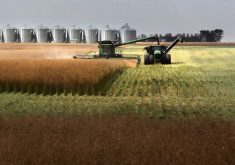The cost of filling your grocery cart in Canada increased by 10.3 per cent in 2022 and is projected to increase by an additional five to seven per cent this year.
In response to this and other concerns, the House of Commons standing committee on agriculture and agri-food initiated studies on food price inflation and global food insecurity. Those included meetings with the heads of four of the five major Canadian grocery retailers and the decision to develop a grocery code of conduct.
The code is meant to address long-standing problems, such as retailers imposing large fee increases on suppliers without notice.
Read Also

Introducing the purple tomato
Health Canada has approved bioengineered The Purple Tomato (TM), maybe leading to new culinary uses and health benefits?
Company executives argued that inflation was due to problems with global supply chains in the aftermath of the pandemic: commodity price increases, labour shortages, transportation bottlenecks, weather disasters and higher energy costs.
On its own, the decision to create a code of conduct could make these meetings worth it.
The code is being drafted by grocers, suppliers and Agriculture and Agri-Food Canada, and seems to prioritize resolving disputes rather than making long-term structural changes to supply chain operation.
This could change in the future. According to members of the code’s steering committee, it will be possible to amend the document once it goes up for review in 18 months.
As an expert in supply chain management, I have recommendations to strengthen relationships and performance across the industry through the code.
The ultimate target of the new code should be consumers, while also securing prosperity of the supply chain. To do this, it should accomplish two things: promoting horizontal competition while also fostering vertical co-operation in the industry.
Horizontal competition refers to rivalry between organizations operating at the same level—competing retailers, for example.
Vertical co-operation aims to strengthen ties between companies at various stages of the supply chain.
Supply chain management practices could be used to foster both goals.
Academic research has documented the successful implementation of these practices across industries, including groceries. There is equally ample evidence highlighting the benefits in areas such as supply and logistics costs, delivery reliability and sustainability.
That research recommends collaborative practices that go beyond the dispute-resolution measures outlined in the code draft.
These practices include:
- Collaborative planning, forecasting and replenishment (CPFR), such as joint forecasting between buyers and suppliers: This aims to improve co-ordination across the supply chain to reduce uncertainty, improve responsiveness and minimize costs such as bloated inventories and expedited orders. CPFR was initially developed by Walmart in 1996 and is used by Ontario’s liquor board.
- Target costing: Under this approach, buyers and suppliers work together to reduce costs and guarantee a maximum selling price while protecting margins. For this approach to be effective, it must be collaborative and include fair distribution of responsibility, authority and benefits among supply chain partners.
- Information sharing: The grocery code could facilitate the distribution and exploitation of knowledge, technologies and best practices across the supply chain. These processes would enable joint problem-solving, improve optimization and the ability to cope with supply and demand variations.
Ultimately, competitive goals should apply to the entire supply chain, rather than to specific stages. It is well-known that squeezing suppliers can, in many instances, quickly erode the supply base. These policies can be severely detrimental not only to the whole industry — including buyers — but also to consumers.
What we need is a comprehensive code of conduct that ensures the long-term sustainability of the industry, while also protecting consumers in the event of future supply imbalances.















